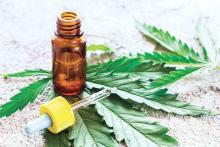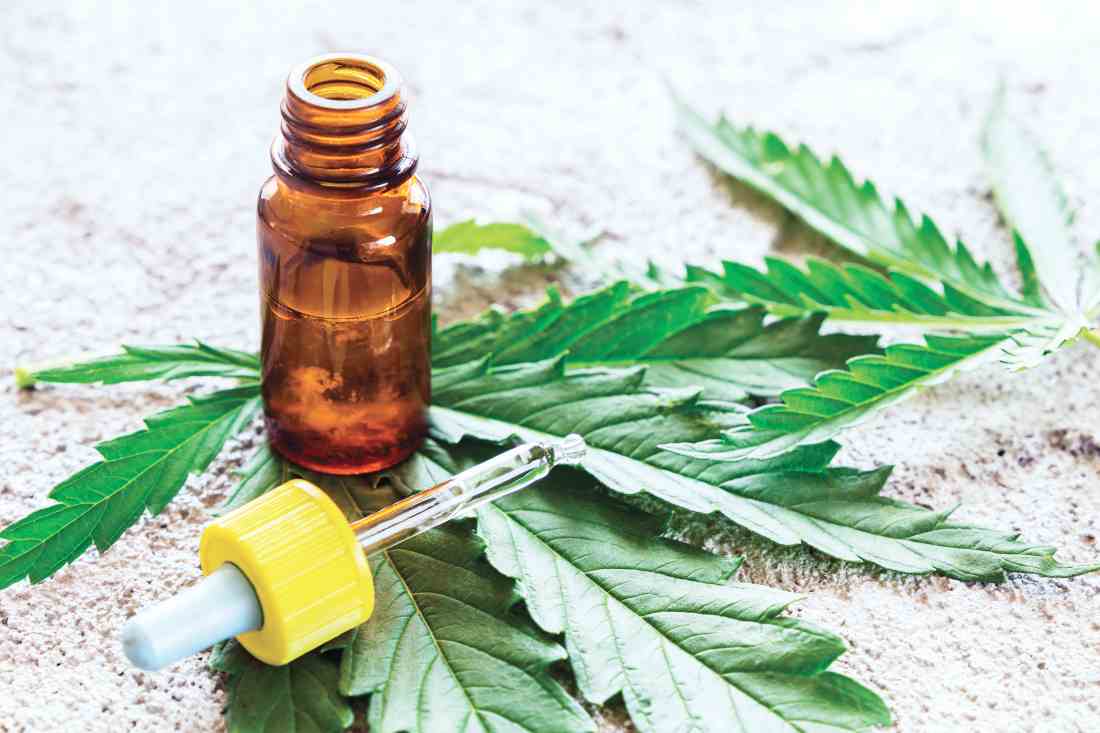User login
Use of cannabidiol (CBD) as an add-on pain management technique in patients with either hand osteoarthritis (OA) or psoriatic arthritis (PsA) did not significantly decrease pain intensity when compared with a placebo in a randomized, double-blind trial described as the first of its kind to investigate the effect of pure CBD as an add-on analgesic therapy in patients with joint disease.
Although data on the use of medical cannabis as a modulator of joint pain are limited, some studies suggest an effect from CBD without the addition of delta-9-tetrahydrocannabinol (THC), wrote Jonathan Vela, MD, of Aalborg (Denmark) University Hospital, and colleagues.
CBD is being used for pain conditions despite a lack of data on safety and effectiveness, the researchers emphasized. Notably, in a 2018 online survey, 62% of respondents reported using CBD for medical conditions, primarily for chronic pain and arthritis or joint pain, they wrote.
In a study published in the journal Pain, the researchers randomized 59 adults with PsA and 77 adults with hand OA to 20-30 mg of synthetic CBD or a placebo daily for 12 weeks in addition to conventional pain management. Patients initially received either oral CBD 10 mg or a placebo tablet once daily, increasing to 10 mg twice daily after 2 weeks, and once again up to 10 mg three times daily at 4 weeks if the patient did not experience more than 20-mm improvement on the visual analog scale (VAS).
The primary outcome in the trial was patient-reported pain intensity during the last 24 hours as assessed on a paper-based 100-mm VAS with the text, “How much pain have you experienced in the most symptomatic joint during the last 24 hours?” with 0 representing no pain and 100 representing the worst pain imaginable.
Overall, both CBD and placebo groups achieved significant reductions in pain intensity of 11-12 mm at 12 weeks. The mean between-group difference on the VAS was 0.23 mm (P = .96). Twenty-two percent of patients who received CBD and 21% who received placebo demonstrated a pain intensity reduction greater than 30 mm on the VAS. Pain reduction greater than 50% was reported by 17 patients (25%) in the CBD group and 16 (27%) in the placebo group. CBD had a similar effect in patients with either PsA or hand OA.
Four serious adverse events occurred during the 12-week study period, but none of these were deemed adverse drug reactions. Serious adverse events in the CBD patients included one case of ductal carcinoma and one case of lipotymia; serious adverse events in the placebo group included one case of acute shoulder fracture and one case of malignant hypertension. Fifty-nine patients reported adverse events during the study. The CBD group reported more ear-nose-throat adverse events, compared with the placebo group (8 vs. 0).
The researchers assessed the impact of CBD vs. placebo on sleep quality, depression, anxiety, or pain catastrophizing scores using the Pittsburgh Sleep Quality Index, Hospital Anxiety and Depression Scale, Pain Catastrophizing Scale, and Health Assessment Questionnaire but found no differences in patients taking CBD vs. placebo.
The study findings were limited by several factors, including the potentially insufficient dose level to evoke a pain relief response, and a lack of data on additional daily use of analgesics or of the study drug beyond the prescribed dosage, the researchers noted.
The results were strengthened by the randomized, double-blind trial design and its relatively large sample size, they wrote. However, the researchers also cautioned that their study focused on CBD as a single ingredient, and the results might not generalize to other CBD formulations. They also noted that more research is needed to examine both higher doses of CBD and different types of pain disorders.
The study was supported by the Danish Psoriasis Foundation Grant and the Danish Rheumatism Foundation. The researchers had no financial conflicts to disclose.
Use of cannabidiol (CBD) as an add-on pain management technique in patients with either hand osteoarthritis (OA) or psoriatic arthritis (PsA) did not significantly decrease pain intensity when compared with a placebo in a randomized, double-blind trial described as the first of its kind to investigate the effect of pure CBD as an add-on analgesic therapy in patients with joint disease.
Although data on the use of medical cannabis as a modulator of joint pain are limited, some studies suggest an effect from CBD without the addition of delta-9-tetrahydrocannabinol (THC), wrote Jonathan Vela, MD, of Aalborg (Denmark) University Hospital, and colleagues.
CBD is being used for pain conditions despite a lack of data on safety and effectiveness, the researchers emphasized. Notably, in a 2018 online survey, 62% of respondents reported using CBD for medical conditions, primarily for chronic pain and arthritis or joint pain, they wrote.
In a study published in the journal Pain, the researchers randomized 59 adults with PsA and 77 adults with hand OA to 20-30 mg of synthetic CBD or a placebo daily for 12 weeks in addition to conventional pain management. Patients initially received either oral CBD 10 mg or a placebo tablet once daily, increasing to 10 mg twice daily after 2 weeks, and once again up to 10 mg three times daily at 4 weeks if the patient did not experience more than 20-mm improvement on the visual analog scale (VAS).
The primary outcome in the trial was patient-reported pain intensity during the last 24 hours as assessed on a paper-based 100-mm VAS with the text, “How much pain have you experienced in the most symptomatic joint during the last 24 hours?” with 0 representing no pain and 100 representing the worst pain imaginable.
Overall, both CBD and placebo groups achieved significant reductions in pain intensity of 11-12 mm at 12 weeks. The mean between-group difference on the VAS was 0.23 mm (P = .96). Twenty-two percent of patients who received CBD and 21% who received placebo demonstrated a pain intensity reduction greater than 30 mm on the VAS. Pain reduction greater than 50% was reported by 17 patients (25%) in the CBD group and 16 (27%) in the placebo group. CBD had a similar effect in patients with either PsA or hand OA.
Four serious adverse events occurred during the 12-week study period, but none of these were deemed adverse drug reactions. Serious adverse events in the CBD patients included one case of ductal carcinoma and one case of lipotymia; serious adverse events in the placebo group included one case of acute shoulder fracture and one case of malignant hypertension. Fifty-nine patients reported adverse events during the study. The CBD group reported more ear-nose-throat adverse events, compared with the placebo group (8 vs. 0).
The researchers assessed the impact of CBD vs. placebo on sleep quality, depression, anxiety, or pain catastrophizing scores using the Pittsburgh Sleep Quality Index, Hospital Anxiety and Depression Scale, Pain Catastrophizing Scale, and Health Assessment Questionnaire but found no differences in patients taking CBD vs. placebo.
The study findings were limited by several factors, including the potentially insufficient dose level to evoke a pain relief response, and a lack of data on additional daily use of analgesics or of the study drug beyond the prescribed dosage, the researchers noted.
The results were strengthened by the randomized, double-blind trial design and its relatively large sample size, they wrote. However, the researchers also cautioned that their study focused on CBD as a single ingredient, and the results might not generalize to other CBD formulations. They also noted that more research is needed to examine both higher doses of CBD and different types of pain disorders.
The study was supported by the Danish Psoriasis Foundation Grant and the Danish Rheumatism Foundation. The researchers had no financial conflicts to disclose.
Use of cannabidiol (CBD) as an add-on pain management technique in patients with either hand osteoarthritis (OA) or psoriatic arthritis (PsA) did not significantly decrease pain intensity when compared with a placebo in a randomized, double-blind trial described as the first of its kind to investigate the effect of pure CBD as an add-on analgesic therapy in patients with joint disease.
Although data on the use of medical cannabis as a modulator of joint pain are limited, some studies suggest an effect from CBD without the addition of delta-9-tetrahydrocannabinol (THC), wrote Jonathan Vela, MD, of Aalborg (Denmark) University Hospital, and colleagues.
CBD is being used for pain conditions despite a lack of data on safety and effectiveness, the researchers emphasized. Notably, in a 2018 online survey, 62% of respondents reported using CBD for medical conditions, primarily for chronic pain and arthritis or joint pain, they wrote.
In a study published in the journal Pain, the researchers randomized 59 adults with PsA and 77 adults with hand OA to 20-30 mg of synthetic CBD or a placebo daily for 12 weeks in addition to conventional pain management. Patients initially received either oral CBD 10 mg or a placebo tablet once daily, increasing to 10 mg twice daily after 2 weeks, and once again up to 10 mg three times daily at 4 weeks if the patient did not experience more than 20-mm improvement on the visual analog scale (VAS).
The primary outcome in the trial was patient-reported pain intensity during the last 24 hours as assessed on a paper-based 100-mm VAS with the text, “How much pain have you experienced in the most symptomatic joint during the last 24 hours?” with 0 representing no pain and 100 representing the worst pain imaginable.
Overall, both CBD and placebo groups achieved significant reductions in pain intensity of 11-12 mm at 12 weeks. The mean between-group difference on the VAS was 0.23 mm (P = .96). Twenty-two percent of patients who received CBD and 21% who received placebo demonstrated a pain intensity reduction greater than 30 mm on the VAS. Pain reduction greater than 50% was reported by 17 patients (25%) in the CBD group and 16 (27%) in the placebo group. CBD had a similar effect in patients with either PsA or hand OA.
Four serious adverse events occurred during the 12-week study period, but none of these were deemed adverse drug reactions. Serious adverse events in the CBD patients included one case of ductal carcinoma and one case of lipotymia; serious adverse events in the placebo group included one case of acute shoulder fracture and one case of malignant hypertension. Fifty-nine patients reported adverse events during the study. The CBD group reported more ear-nose-throat adverse events, compared with the placebo group (8 vs. 0).
The researchers assessed the impact of CBD vs. placebo on sleep quality, depression, anxiety, or pain catastrophizing scores using the Pittsburgh Sleep Quality Index, Hospital Anxiety and Depression Scale, Pain Catastrophizing Scale, and Health Assessment Questionnaire but found no differences in patients taking CBD vs. placebo.
The study findings were limited by several factors, including the potentially insufficient dose level to evoke a pain relief response, and a lack of data on additional daily use of analgesics or of the study drug beyond the prescribed dosage, the researchers noted.
The results were strengthened by the randomized, double-blind trial design and its relatively large sample size, they wrote. However, the researchers also cautioned that their study focused on CBD as a single ingredient, and the results might not generalize to other CBD formulations. They also noted that more research is needed to examine both higher doses of CBD and different types of pain disorders.
The study was supported by the Danish Psoriasis Foundation Grant and the Danish Rheumatism Foundation. The researchers had no financial conflicts to disclose.
FROM PAIN

